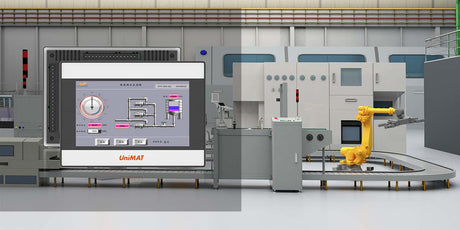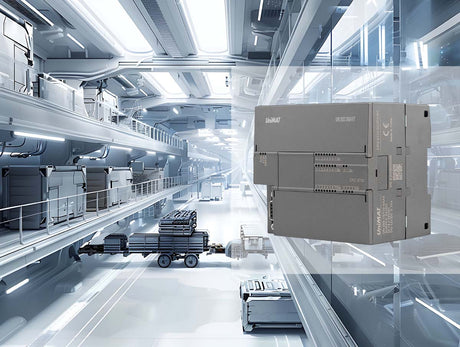In industrial automation,choosing the right control system can make or break your operational efficiency.Two leading solutions—Programmable Logic Controllers(PLCs)and Programmable Automation Controllers(PACs)—are often compared,but their differences aren’t always clear.This article breaks down the key distinctions between PLCs and PACs,helping you decide which system aligns best with your factory’s requirements.

What Are PLCs and PACs?
Before diving into differences,let’s define both technologies:
PLCs(Programmable Logic Controllers):
Developed in the 1960s,PLCs are rugged,purpose-built devices designed for simple to moderate industrial control tasks.They excel at logic-based operations,such as controlling machinery,conveyor belts,or assembly lines.
PACs(Programmable Automation Controllers):
Emerging in the early 2000s,PACs combine the reliability of PLCs with the advanced capabilities of PCs.They handle complex automation tasks,including data logging,motion control,and network communication,while supporting multiple programming languages.
Core Differences Between PLCs and PACs
Understanding these five factors will clarify which system suits your needs:
1.Processing Power and Complexity
PLCs:Optimized for deterministic,repetitive tasks(e.g.,turning motors on/off,reading sensors).Their processors are tailored for speed in logic execution but lack the horsepower for complex algorithms.
PACs:Built with high-performance processors capable of multitasking.They manage advanced processes like vision systems,predictive maintenance analytics,and database integration.
Key Takeaway:PLCs are ideal for straightforward control;PACs thrive in data-heavy,multifunctional environments.
2.Programming Flexibility
PLCs:Typically programmed using ladder logic,a graphical language familiar to electricians and technicians.Some models support limited structured text.
PACs:Support multiple programming languages(IEC 61131-3 standards),including ladder logic,structured text,function block diagrams,and even C/C++.This flexibility suits engineers developing complex,customized solutions.
Key Takeaway:PLCs prioritize simplicity;PACs offer versatility for intricate programming needs.
3.Hardware Architecture
PLCs:Use a closed,modular architecture.Expansion is possible via I/O modules,but processing power is fixed.
PACs:Feature open,scalable architectures with modular components and support for third-party hardware/software.This makes PACs easier to upgrade or integrate with IoT platforms.
Key Takeaway:PLCs are cost-effective for static systems;PACs adapt to evolving automation demands.
4.Data Handling and Connectivity
PLCs:Focus on real-time control,with limited data storage and communication capabilities(e.g.,basic Ethernet,RS-485).
PACs:Designed for big data and Industry 4.0.They include built-in networking(Ethernet/IP,OPC UA),cloud connectivity,and tools for aggregating and analyzing machine data.
Key Takeaway:PACs are better suited for smart factories requiring data-driven decision-making.
5.Cost and Maintenance
PLCs:Generally lower upfront costs and easier to maintain due to simpler programming and widespread technician expertise.
PACs:Higher initial investment but lower long-term costs for complex systems,thanks to reduced hardware sprawl and advanced diagnostics.

When to Choose a PLC vs PAC
Use this decision-making guide based on your application:
Choose a PLC If:
Your tasks are logic-based and repetitive(e.g.,packaging machines,HVAC control).
You need a budget-friendly solution with minimal training requirements.
Your facility lacks IT infrastructure for advanced data systems.
Choose a PAC If:
Your operations involve multi-domain control(e.g.,robotics,vision systems,energy management).
You require seamless integration with ERP/MES systems or cloud platforms.
Future scalability and IoT readiness are priorities.
Industry Examples:PLC vs PAC in Action
Automotive Assembly Line(PLC):A PLC controls welding robots and conveyor timing with precision.
Pharmaceutical Plant(PAC):A PAC manages batch processing,tracks environmental data,and syncs with QA databases.
The Future of Industrial Control Systems
As factories adopt AI,machine learning,and IoT,PACs are becoming the backbone of smart manufacturing.However,PLCs remain indispensable for simpler,high-reliability tasks.The choice ultimately hinges on your operational complexity and growth strategy.
Final Verdict
PLCs=Simplicity,reliability,and affordability for basic automation.
PACs=Advanced functionality,scalability,and future-proofing for Industry 4.0.
By understanding the industrial PLC vs PAC differences,you can invest in a system that maximizes productivity without over-engineering—or under-delivering.For questions about PLC,please contact Unimat at office@unimatautomation.com









